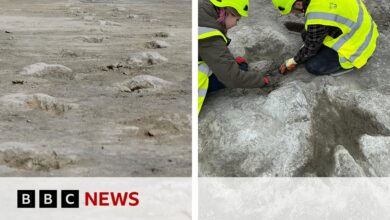This Is Why CIA Is Hiding an Advanced Civilization in Sahara Desert

**Strange Discoveries in the Sahara Desert**
The Sahara Desert is known for its vast stretches of sand, but it also hides many intriguing curiosities. Here are 20 of the strangest findings in this expansive region.
1. **The Pyramids of Meroë**
Located in ancient Sudan, the Meroë pyramids date back nearly 5,000 years and were constructed by the Nubian Kings of the Kingdom of Kush. Archaeologists in the 1800s found these pyramids, which had been heavily plundered by grave robbers. Unfortunately, an explorer named J.P.I. Ferini further damaged the site by destroying the tops of 40 pyramids during excavations, which is why they differ from their Egyptian counterparts.
2. **CIA’s Hidden Civilization**
A recent Reddit story claims a man stumbled upon a CIA-run hidden civilization in the Sahara. During an expedition, he became separated from his group and discovered an extraordinary sight, convincing him of its existence. However, upon trying to lead his group back, he couldn’t find it again, leaving the reality of his discovery in question.
3. **Waw an-Namus**
This unique volcanic field in southern Libya, known as the “Oasis of Mosquitoes,” features a central caldera with a saltwater lake, often referred to as the “Eye of the Sahara.” Its turquoise waters create a striking contrast against the desert landscape. Due to its remote location, this site remains largely untouched, allowing researchers to study its unique geological features.
4. **Fossils of Early Whales**
The UNESCO World Heritage site Wadi Al Hitan in Egypt is home to hundreds of fossils, including those of some of the earliest whales, which were believed to have evolved from land-dwelling animals. Notably, these early whales had five-fingered flippers and hind legs, indicating their transition from land to sea.
5. **Libyan Desert Glass**
This translucent yellow-green glass is believed to have formed from a meteorite impact about 29 million years ago. The glass, which varies in size and color, was historically significant in ancient Egyptian civilization, used for jewelry and decorative items.
6. **Rashad Structure**
Astronauts have marveled at the circular Rashad Structure, resembling a bullseye, which formed through erosion of rock layers. Its unique appearance is best appreciated from space, making it a fascinating geological feature.
7. **Ancient Rock Art at Tassili n’Ajjer**
This vast plateau in Algeria is home to ancient rock formations and prehistoric rock art, some dating back 12,000 years. These paintings provide insight into the daily life, animals, and hunting practices of prehistoric humans.
8. **Cave of Swimmers**
Located in the Libyan Desert, this cave features rock paintings of human figures swimming, estimated to be around 10,000 years old. The artwork indicates that the region had a different climate and landscape in prehistoric times.
9. **Timbuktu**
Founded in the 12th century, Timbuktu became a major trade center in West Africa, known for its scholarly significance during the 15th and 16th centuries. Despite its UNESCO World Heritage status, many historical sites were destroyed during the 2012 insurgency.
10. **Chott el Jerid**
This is the largest salt pan in the Sahara, covering approximately 7,000 square kilometers. The salt crust forms from evaporated water, creating a shimmering landscape that attracts filmmakers. The region is also vital for local communities who harvest salt.
11. **Mosasaurus Rex**
In 2016, paleontologists discovered fossilized remains of a massive ancient crocodile, named Mosasaurus Rex, near the Sahara. This creature, measuring over 32 feet long and weighing around 6,600 pounds, had adaptations for ocean living, differing from modern crocodiles.
12. **Naqada in Egypt’s Western Desert**
Naqada is an archaeological site featuring dry lake beds and megalithic structures over 6,000 years old, showcasing early nomadic and pastoral life.
13. **Indigenous Underground Homes**
The indigenous people of North Africa have created unique underground homes as a way to escape the intense heat of the desert. These dwellings are dug into the earth, allowing for natural temperature regulation. Each home typically features a central sunken courtyard, often with a well, surrounded by small chambers connected by passageways. Access to these homes is usually through a ladder or tunnel, reflecting a clever adaptation to their environment.
14. **World War II P40 Kittyhawk**
In 2012, a crashed Royal Air Force P40 Kittyhawk fighter plane from World War II was discovered in the Sahara Desert, with the body of the pilot still inside. This American-made aircraft, designed by Curtis Wright, played a significant role in ground attack missions and aerial dogfights. It was particularly active in North Africa, supporting Allied troops by targeting enemy forces.
15. **Massive Dinosaur Fossil Cache**
A vast collection of dinosaur bones, weighing over 20 tons, was found buried in the sands of the Sahara. Scientists believe these fossils, including vertebrae from a large dinosaur, date back approximately 200 million years when the area was a lush, green environment rather than the dry desert it is today. This discovery offers valuable insights into prehistoric life and the geological history of the region.
16. **Gobero Skeletons**
In a remote area of the Sahara known as Gobero, archaeologists uncovered remarkably preserved human skeletons that date back over 10,000 years. Led by Paul Sereno from the University of Chicago, the excavation revealed vital information about human adaptation during significant climate changes. The desert’s unique preservation conditions, combined with protective sand dunes, have kept these remains well intact, allowing researchers to study the physical characteristics, health, and burial practices of ancient people.
17. **Lost Fortresses of the Garamantes**
The Garamantes were an ancient civilization that inhabited the region now known as modern-day Libya from 500 BC to 700 BC. They developed advanced irrigation techniques, creating a network of underground channels called **feras**, which allowed them to cultivate crops in the harsh desert environment. The Garamantes engaged in trade with neighboring civilizations, including the Romans, exchanging goods such as salt, gold, and slaves. Remnants of their society, including tombs, temples, and fortresses, provide insight into their way of life.
18. **Buried River Systems**
In 2015, radar images revealed evidence of a buried river system that once stretched over 500 kilometers across the Sahara Desert. This finding suggests that, despite the current arid conditions, the region likely supported a vibrant ecosystem with diverse plant and animal life thousands of years ago. Studies indicate that the river may have originated in the Atlas Mountains and could have contributed to a more diverse landscape 5,000 to 6,000 years ago.
19. **Meteorites and Craters**
The Tumer crater in the Sahara, located in Mauritania, is a nearly circular formation about 1.5 kilometers in diameter, estimated to have been formed around 21,400 years ago. Initially debated as a volcanic formation, evidence now points to a meteorite impact as the cause. This crater contains shocked quartz and other geological features that indicate a significant impact event, intriguing scientists and sparking curiosity about its origins.
20. **Saharan Horned Viper**
The Saharan horned viper, a species native to the Sahara Desert, has evolved remarkable adaptations for survival in extreme conditions. Its pale yellow-brown and gray coloration allows it to blend seamlessly into the sandy environment. The horns above its eyes serve a dual purpose: they are not only a distinctive feature but also help regulate the snake’s body temperature. This viper primarily hunts small mammals, birds, and occasionally other reptiles, using an ambush technique to catch its prey. Despite its venomous bite, the Saharan horned viper is not aggressive toward humans and relies on camouflage to evade threats.
These discoveries highlight the Sahara’s rich history and the adaptability of life in such a harsh environment. Which of these fascinating finds captures your imagination the most? Share your thoughts in the comments!








